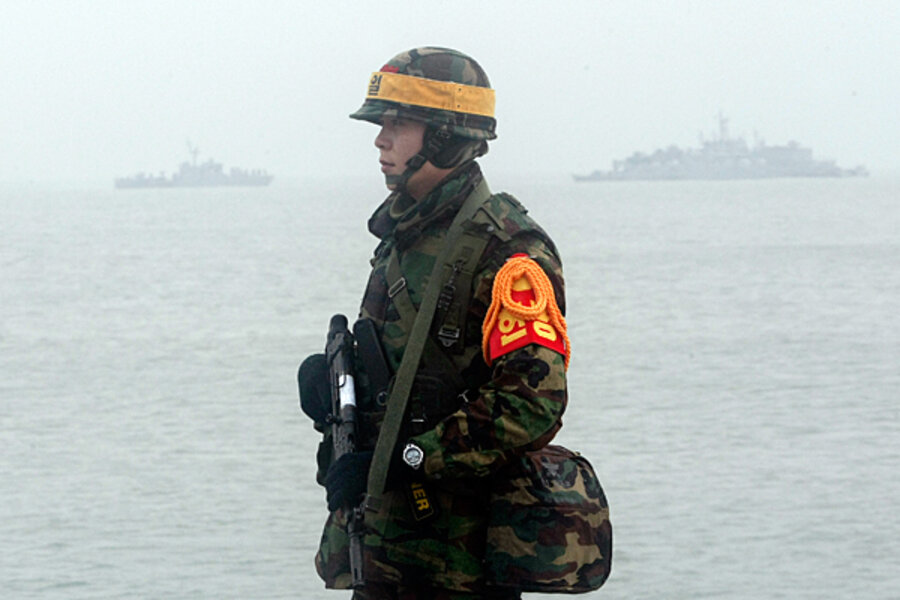North Korea threats unlikely to dissuade South from planned military drill
Loading...
| Washington
North and South Korea have raised the stakes in their confrontation in the Yellow Sea with challenges that analysts say are making it difficult for either side to back down easily.
In the face of South Korean plans to stage a live-fire exercise from the island that North Korea hit Nov. 23 with a deadly artillery barrage, the North promises to respond with “self-defensive blows” of an “intensity and range” far greater than before.
Pyongyang’s Korean Central News Agency issued the statement, attributed to an anonymous colonel, in the midst of a flurry of efforts to ease escalating tensions, including a visit to Pyongyang by New Mexico Gov. Bill Richardson.
“It’s worse than a game of chicken,” says Han Sung-joo, a former South Korean foreign minister who has also been ambassador to the US. “We’ll have to wait it out.”
However North Korea fulminates, South Korean analysts say the South has to go through with the exercises as planned within the next few days.
“That can’t stop South Korea from doing what it plans to do,” says Mr. Han, who now chairs the influential Asan Institute in Seoul. As for North Korea’s statement, he says, “It’s not the first time for their huffing and puffing.”
Gov. Richardson's visit
One reason North Korea may not repeat last month’s attack on Yeonpyeong Island, in which two South Korean marines and two civilians were killed, is the visit of Gov. Richardson, accompanied by a CNN crew, to Pyongyang.
“They’ll probably show them the uranium enrichment program,” says Han. “That should be threatening enough.”
After talks Friday with North Korean officials, Richardson is expected to visit the North Korean nuclear complex in Yongbyon, north of Pyongyang, where North Korea has nearly completed a facility with a 20-megawatt reactor for producing highly enriched uranium.
North Korea showed the facility to a US delegation led by nuclear physicist Siegfried Hecker in November, two weeks before the Yeonpyeong attack.
The uranium program marks a major step beyond North Korea’s production of nuclear devices with plutonium at their core, extracted from a five-megawatt reactor at the same complex. The North has already conducted two underground tests of plutonium devices and is believed to be gearing up to test a uranium device within a few months.
The presence of the CNN team, led by Wolf Blitzer, adds to the impact of Richardson’s visit. “CNN will film their program,” says Han. “It’s good propaganda for them.”
The question now is whether Richardson will still be in Pyongyang if and when the South fires artillery shells into waters south of Yeonpyong Island.
North Korea claims the area as within its territorial limits though it's south of the Northern Limit Line, which was set by the US and South Korea after the Korean War. The North has challenged the line in a number of incidents in recent years.
Richardson, who has visited Pyongyang three times previously, said that he hopes his trip will “make a difference” in efforts to bring about peace.
South Korea's tougher stance
South Korea’s President Lee Myung-bak faced severe criticism for what was seen as a weak response to the Nov. 23 attack.
South Korean marines shot about 80 rounds toward vaguely defined North Korean targets in response to the North Korean strike in which the North fired more than twice that many shells on Yeonpyeong.
"South Korea should do the exercises," says Choi Jin-wook, chief North Korea analyst at the Korea Institute of National Unification. “Otherwise it’s going to lose face too much.”
The exercises are seen as a major test for South Korea’s new defense minister, Kim Kwan-jin, former chairman of South Korea’s joint chiefs of staff, who has threatened to respond with concentrated attacks on North Korean positions if the North attacks again. One central question is whether he would order air strikes on targets inside North Korea – something that has not happened since the Korean War.
Pyongyang’s Korean Central News Agency called Mr. Kim “a puppy knowing no fear of a target” in a commentary on what it said were the South’s plans to stage “madcap exercises.”
Mr. Choi says North Korea is making a supreme effort to get the attention of Washington and Beijing – and obtain direly needed aid in renewed negotiations. In fact, US Deputy Secretary of State James Steinberg was in Beijing on Friday on a mission to persuade China to bring pressure on North Korea to end the confrontation.
Choi doubts, however, if the mission will succeed. “The trains are on the tracks from opposite directions,” he says. “It’s as though they are about to crash. North Korea can’t avoid it, and South Korea can’t avoid it. They will lose support if they do.”





